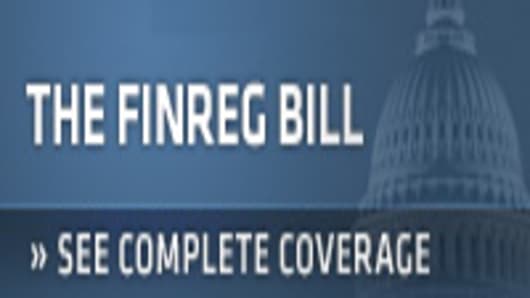The new limits on proprietary trading and hedge fund investments may actually benefit big banks more than harm them—especially in the hedge funds they market to clients.
The Obama administration had proposed an outright ban on banks engaging in proprietary trading and sponsoring hedge funds. The ban—nicknamed the Volcker rule because it was championed by former Federal Reserve Chairman Paul Volcker—was softened last night as lawmakers reached agreement on a major financial overhaul bill.
Under the final version of the bill, banks will be allowed to invest up to 3 percent of their own capital in proprietary trading or a hedge fund they operate for clients.
"Prop" trading, as it is often called, is when banks risk their own money to invest in financial markets. Though it has been very profitable for banks, the practice was blamed for helping to cause the 2008 financial crisis.
The 3 percent limit, which seems restrictive, actually isn't. The reason is that most of the biggest banks — including Bank of America, Citigroup, and Morgan Stanley — already are within that range on propriety trading, so not much will change.
Goldman Sachs may be one of the few banks that will have to reduce its proprietary trading or perhaps spin off prop trading operations into separate hedge funds. However, it could avoid the restrictions altogether if it stopped being a bank holding company, which it only became in 2008.
The 3 percent limit also doesn't have a big impact on the hedge funds that banks own—and may actually be an unintended benefit. That's because banks are far more interested in the management fees they charge for in-house hedge funds—usually 2% of the total assets and 20% of the trading gains—than any profits the funds generate for the bank's bottom line.
This is one of the reasons banks have increasingly turned toward managing hedge funds instead of pure proprietary trading, which is a lot riskier.
The new limit will now give the banks an excuse to reduce the amount of capital they commit to a hedge fund, which was mostly done to convince clients that the banks had "skin in the game." In fact, banks were being forced to commit more and more money to the funds to compete against other funds.
At Goldman Sachs, for instance, some hedge funds were pitched to outsiders as very attractive because the company and its employees were the largest investors in the fund.
By creating a ceiling of 3% in any single fund, the Volcker rule will now allow banks to say they have fully committed the legal maximum amount of capital to the fund. Customers will not be able to demand a larger commitment. The arms race stops at a stake of just 3%.
Although the final text of the rule is not yet available, it appears likely that banks will still be able to charge fees based on the total amount of assets managed by the hedge funds they sponsor as well as collect a portion of the gains. It also appears that employees of banks that sponsor funds will not fall under the 3% limit.
This means that to the extent Goldman executives, for example, want to capture more of the upside of a particular fund for themselves, they can simply invest as individuals rather than put in more firm money. To the extent that the rule requires banks to sell down outsized stakes in some of their sponsored hedge funds, many of these sales may be to their own employees.
There will certainly be big changes in bank sponsored hedge funds, with banks required to sell off stakes in funds in which they’ve taken a large positions. But when it comes to marketing new funds—or even changing the rules governing a bank’s commitment to hold a big stake in an existing fund—banks will now enjoy the privilege of not having to put too much of that proverbial skin in the game.




